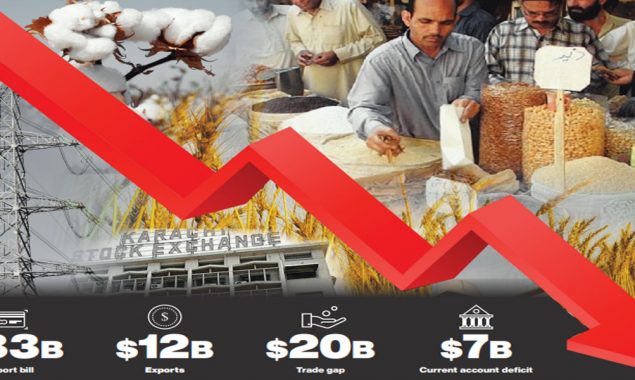
Experts believe SBP’s measures are too little
Pakistan is heading towards a serious balance of payments crisis due to an alarming trade gap of $20 billion and the rising current account deficit of $7 billion in the first five months of the current fiscal year.
The higher-than-expected foreign exchange payments have created an instability in the value of the rupee and higher inflation, making lives of the general public miserable.
“The current balance of external payments situation shows that a crisis lies ahead. The trade deficit is at $20 billion, which is 15 per cent of the GDP,” Miftah Ismail, a senior PML-N leader and former finance minister, told Bol News.
Pakistan’s trade deficit swelled to $20.65 billion during the first five months (July-November) of fiscal 2021/22. This is mainly due to the burgeoning import bill that shot up to $33 billion during the same period.
Similarly, the current account deficit ballooned to $7.1 billion during the first five months of the current fiscal year, compared with a surplus of $1.87 billion in the corresponding period of the last fiscal.
For the last three years, the PTI government has been taking the credit for lower twin deficits without improvement in other indicators. But now these deficits are exposing the structural weaknesses of the Pakistani economy, which the government has failed to address.
“These issues were there even during the days of our government, but we kept the wheels of the economy moving, which resulted in continuous GDP growth,” Ismail said.
He; however, said that despite the fragile economic conditions, Pakistan will not face any default. “But the country is moving in the wrong direction.”
Pakistan’s exports jumped 27 per cent to $12.36 billion during the first five months of the current fiscal year, compared with $9.74 billion in the corresponding months of the last fiscal year. However, these numbers are not sufficient to feed the import payment requirements.
“The export receipts are required to make payment for foreign payments. At present, the import/export ratio has fallen to 37 per cent, whereas it was 45 per cent during our government,” Ismail said.
The country’s import bill showed a significant increase during the current fiscal year, growing at the rate of $6.6 billion per month. This means the country requires $79.2 billion to feed the import requirement by the end of the current fiscal.
The import bill for November 2021 increased sharply to $7.9 billion, showing a growth of 85 per cent, compared with $4.29 billion during the same period of the previous financial year.
Considering the present payment trend, Pakistan has an import cover of 2.3 months, which is less than the international standard of three months. The official foreign exchange reserves of the State Bank of Pakistan (SBP) were $18.57 billion by the week ended December 10, 2021. This also includes $3 billion placed by the Saudi Fund for Development (SFD) with the central bank.
This Saudi support is a ceremonial deposit, placed at 4.0 per cent for a year. Excluding this amount, the import cover is for 1.97 months.
The lowering import coverage has resulted in a massive depreciation in the local currency, which has tumbled 13 per cent against the dollar since the start of the current fiscal year. Currently, it hovering at its historic low of around Rs178.15 against the dollar in the interbank market on December 22, 2021.
The rise in the payment for foreign purchases may be attributed to ease in cases of coronavirus pandemic and revival of the domestic economy; massive rise in the international oil prices; and a surge in the prices of commodities in the international markets also contributed to the rising import bill.
Last but not the least, Afghanistan’s volatile situation; following the United States froze Kabul’s foreign exchange reserves as the Taliban seized power also remains a factor creating financial instability.
Khurram Schehzad, chief executive officer of the Alpha Beta Core, a venture investment company, said that currency smuggling to the neighbouring countries remains a major problem. “The unabated outflow of the Pakistani rupee has created instability in the exchange rate.”
“The currency in circulation shot up to a massive 40 per cent, which is much higher, compared with the other economies,” said Schehzad, adding that the cash is not just in the hands of Pakistanis, but also in the hands of Afghans and others.
Since the foreign currency accounts of Afghanistan were frozen and the neighbouring country needs imported goods for their domestic requirement, a huge number of exports were made by Pakistanis.
The Pakistani importers are buying foreign goods in dollars and smuggling them out to Afghanistan against the rupee transactions, the Alpha Beta Core CEO explained.
Over the last few weeks, the SBP took some measures to lessen the dollar outflows and reduce domestic demand to arrest inflation and support the local currency. But experts say that these measures are too little, and have been taken too late.
The SBP’s measures include imposition of limits on foreign exchange buying by individuals from the open market; hikes in the key policy rate by 150 basis points and 100bps to 9.75 per cent, respectively, during a short span of time; amendment in the instructions for exchange companies under which the exchange companies are now required to obtain identification documents such as CNIC on transactions above $500; and reducing retention period to three days by exchange companies for foreign receipts, including exports and remittances.
Besides, the SBP decided to impose 100 per cent cash margin requirement (CMR) on the import of 114 items, taking the total number of items subject to cash margin to 525; and revising the prudential regulations for consumer financing.
The step was taken to moderate demand growth in the economy, leading to slower import growth and; thus, supporting the balance of payments position.
The changes in the prudential regulations effectively prohibit financing for imported vehicles, and tighten the regulatory requirements for financing domestically manufactured/assembled vehicles of more than 1000cc engine capacity and other consumer finance facilities such as personal loans and credit cards. But all these measures failed the free-fall of the rupee.
Former president of the Federation of Pakistan Chambers of Commerce and Industry (FPCCI) and chairman of Businessmen Panel (BMP) Anjum Nisar said: “The SBP should take some stern measures to discourage the imports of luxury items and encourage domestic manufacturing.”
The higher import bill and free float of the local currency resulted in inflationary pressure. The central bank itself admitted the inflation rose more sharply-than-expected.
In the last two monetary policy announcements, the SBP increased the discount rate by 250 basis points to 9.75 per cent. The business community believes higher interest rates would increase the cost of doing business and make domestic products uncompetitive, which would result in more imports in the near future.
The hike in the key policy rate would be counterproductive for the industry, he said, adding: “This will increase the cost of doing business and domestic manufacturers will lose competitiveness.”
These measures would close down industries and promote imported products in the local market, he added. “The rising cost domestically would help other regional markets.”
“The interest rate is 4.0 to 5.0 per cent in regional economies, including India, Bangladesh and China,” he said, adding that their goods would find their way into Pakistan.
“The government must take immediate action to curtail the trade deficit. There should be a complete ban on the import of luxury and non-essential items for some time.”
Controlling inflation will be a gigantic task for the government. However, timely decisions may give some respite in the future.
Historically, Pakistan was known as an agrarian economy. The country has five major crops, including cotton, sugarcane, rice, maize and wheat. Unfortunately, the crop situation deteriorated over the years and now the country is even importing sugar and wheat.
The food import bill recorded a 54 per cent increase to $8.34 billion in fiscal 2020-21, compared with $5.42 billion in the preceding fiscal year. A better agriculture policy may help reduce the food import bill.
In 1959, the country got its first industrial policy. Following this a massive shift was seen towards industrialisation. But over the years, the industry witnessed difficult times, especially because of the electricity shortages, deteriorating law and order situation and corruption.
Many industrial units shifted abroad and those who remained in the country are still struggling.
Pakistan’s import bill shot up to $56.4 billion in the fiscal 2020-21, compared with $44.55 billion in the preceding fiscal year, showing an increase of 26.60 per cent. The surge in the import bill is even sharper during the first five months of the current fiscal.
Dr Reza Baqir, the SBP’s controversial governor, in his maiden press conference in June 2018 after taking the charge of his office had made it clear that the central bank would allow the market forces to decide the exchange rate.
However, it was also assured that the central bank would intervene, if there is volatility. Since the press conference of the SBP governor, the rupee has lost around 47 per cent in value. The rupee was at Rs121.39 against the dollar on June 14, 2018.
Major market players and leading economists blame the SBP for sharp depreciation in the Pakistani currency as it took no steps to prevent the free-fall of the rupee under the International Monetary Fund’s programme.
Experts say that the government needs to take measures to stop unnecessary imports and encourage locally-produced consumable items. The local market is flooded with imported goods, which include all the finished products that can be locally produced. At the same time, measures need to be taken to stabilize the currency market and make environment conducive for investment and business.
Read More News On
Catch all the Business News, Breaking News Event and Latest News Updates on The BOL News
Download The BOL News App to get the Daily News Update & Follow us on Google News.




